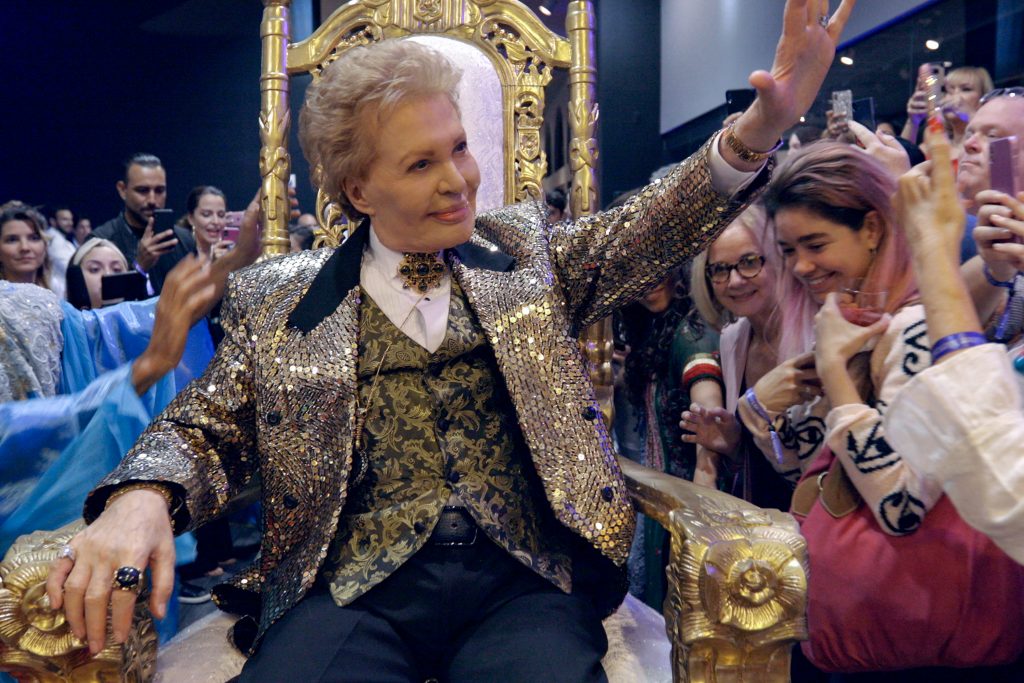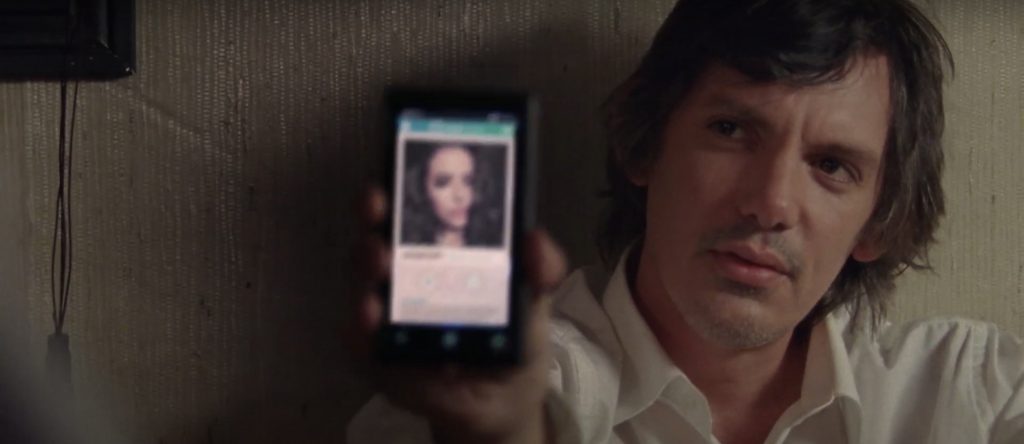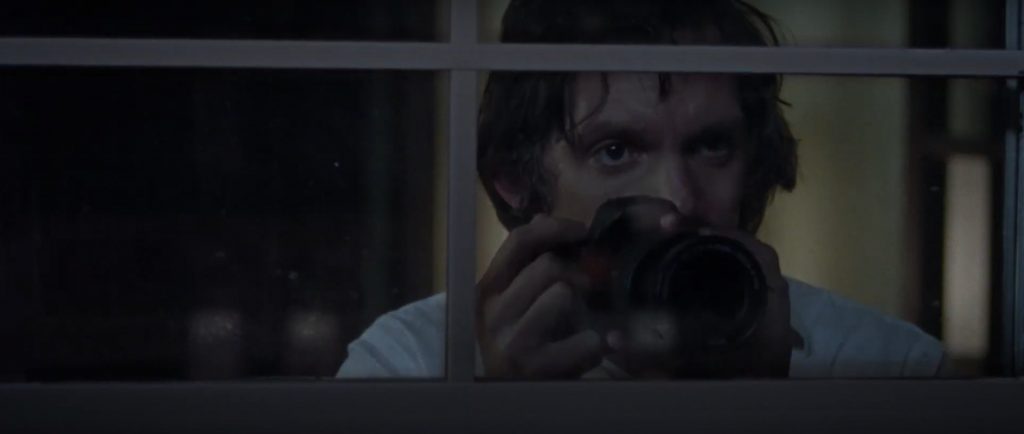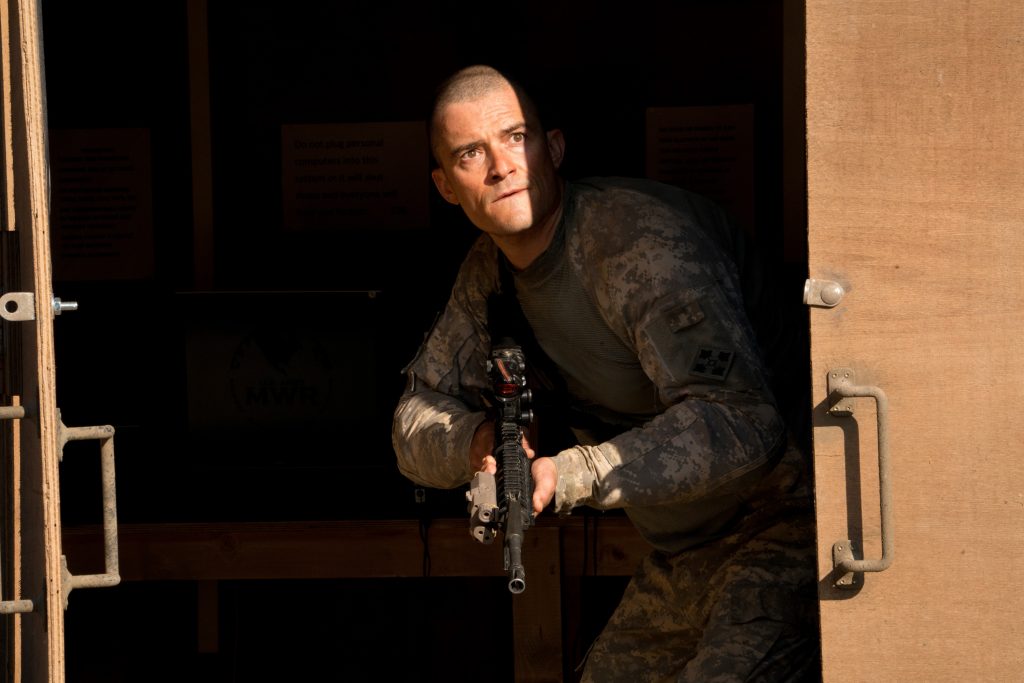July 10, 2020
by Carla Hay
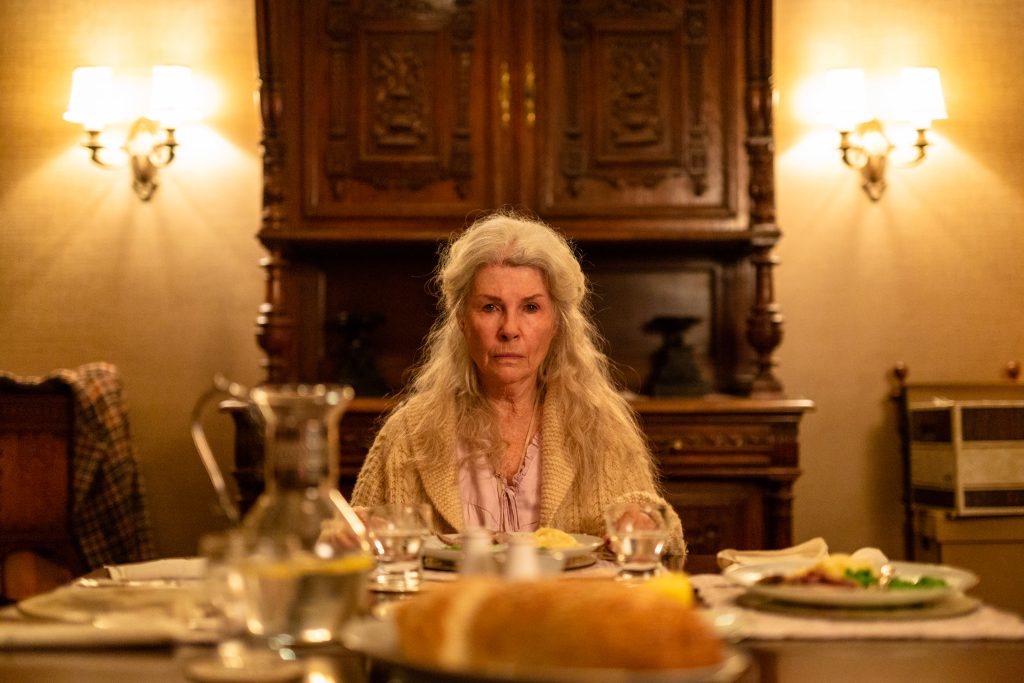
Directed by Natalie Erika James
Culture Representation: Taking place in Australia, the horror film “The Relic” has an all-white cast representing the middle-class.
Culture Clash: An elderly woman, who shows signs of dementia, is convinced that something evil is out to get her, while her daughter and granddaughter who come to visit have very different reactions to her distress.
Culture Audience: “Relic” will appeal primarily to people who don’t mind slow-paced, “slow burn” horror films, because most of the action doesn’t happen until the last 20 minutes of the film.
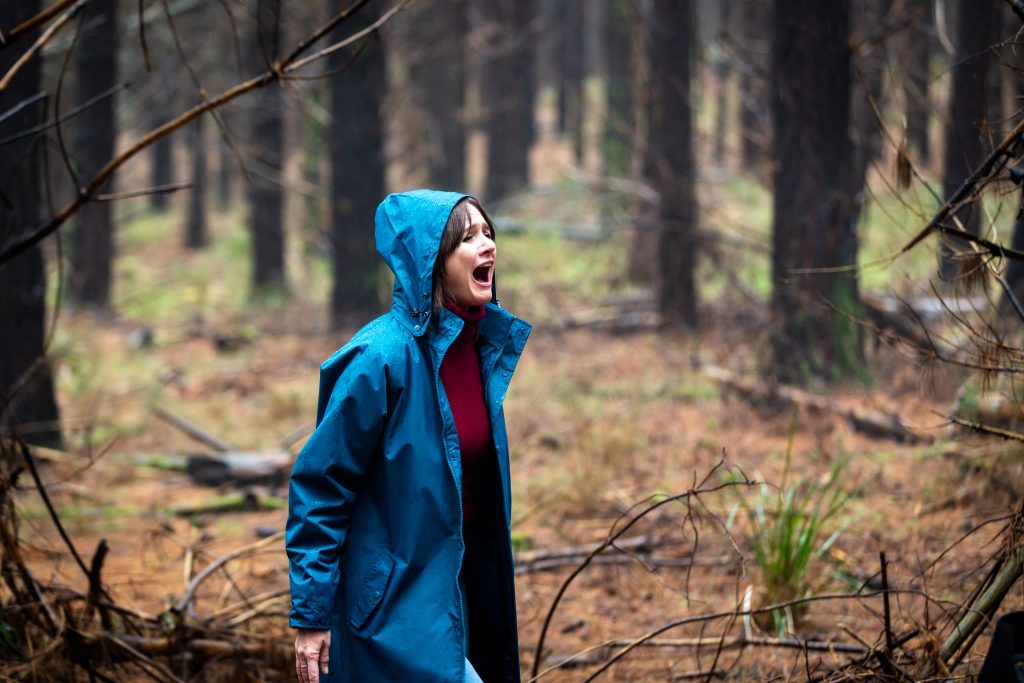
Is “Relic” a haunted house film or a psychological horror film? The movie can be considered both, but it’s really more of the latter. “Relic” (the feature-film debut of director Natalie Erika James) is not the kind of movie for people who like fast-paced action throughout most of the film. Nor will it satisfy people who expect a full explanation for all the horror that goes on in the story. Instead, “Relic” is the type of movie that creeps up on viewers in the type of slowly rotting way that’s similar to the mysterious dark mold that malignantly spreads throughout the haunted house in this movie.
“Relic” begins with an eerie scene of an upstairs bathtub overrunning with water in a dark and creepy two-story house, with the water eventually flowing down the stairs. Meanwhile, a naked elderly woman with long, flowing white hair is standing in a daze downstairs, looking at a lit Christmas tree’s lights that are blinking. The woman is alone in the house, which is filled with lit candles. Is this a witch?
Not exactly. It turns out the woman is a widow named Edna (played by Robyn Nevin) who lives alone in the house, which is in a remote wooded area of Australia. (Melbourne is the closest big city.) The next thing that viewers find out about her is that she has disappeared. Edna’s no-nonsense daughter Kay (played by Emily Mortimer) and Kay’s aimless daughter Sam (played by Bella Heathcote) have driven from Melbourne to Edna’s house, after finding out from a neighbor that Edna has gone missing.
When Kay and Sam arrive, they see that Edna’s bed is unmade and her possessions are still in the house. Sam also notices that there are strange mold-like stains and marks in Edna’s bedroom closet. It’s been a few weeks since Kay last spoke to her mother, while Edna’s middle-aged neighbor Alex (played by Jeremy Stanford) says that he hasn’t seen Edna for a few days.
Kay files a missing person’s report with the local police, while Kay and Sam also join the search party in the woods. Kay has told the police that Edna has flooded the bathtub before, by forgetting to turn off the faucet. The implication is clear that Edna’s forgetful ways and mysterious disappearance might be signs of Edna having dementia.
Kay and Sam have a tense relationship because Kay is frustrated that Sam hasn’t quite figured out what to do with her life. Sam tells Kay that she recently quit her job at a gallery and that she’s gone back to working in a bar. When Kay asks Sam if Sam plans to go back to college, Sam says that she doesn’t know what her future plans will be. An exasperated Kay tells Sam that she can’t work in a bar for her whole life, but Sam just tries to shrug off her mother’s concerns.
One night, while Edna is still missing, Sam is smoking a joint out on the house’s front porch, when she sees a neighbor named Jamie (played by Chris Brunton) coming over to the house and greets him in a friendly manner. Jamie, who is Alex’s son, is an 18-year-old with Down syndrome whom Sam has met before but she hasn’t seen in in several years. Sam comments to Jamie on how much he’s grown up, and she lets him have a hit off of her joint when he asks her. It’s revealed later in the story that Alex and Jamie have been keeping their distance from Edna because of a disturbing incident that happened with Edna not too long ago.
While the search continues for Edna, there’s some information about Edna that Kay didn’t tell the police but she tells Sam in a private conversation that they have at the house. A few weeks prior, Edna called Kay and told Kay that Edna suspected that an intruder was coming into the house, because doors were left open and furniture was rearranged. While Sam believes that Edna could be in real danger, Kay dismisses that notion by saying that Edna probably caused those changes in the house herself and forgot about it.
Meanwhile, some more strange things occur. One day, while Sam is wearing one of Edna’s long sweaters, she finds a note in the pocket that says, “Don’t Follow It.” And she also notices that a large mold-like stain is on a living room wall when the stain apparently wasn’t there when Sam and Kay first arrived at the house.
After disappearing for three days, Edna suddenly comes back to the house. Kay is startled to see Edna calmly cutting up food in the kitchen sink and acting very unaware that several people had been looking for her. Kay’s exasperation with Edna increases when Edna refuses to say where she was and what she was doing when she disappeared, even though Kay later finds blood on Edna’s nightgown.
Edna is given a wellness exam at her home to determine her mental and physical health. It’s determined that Edna is healthy, but she’s cautioned not to wander outside. Kay has her doubts about how well Edna is, while Sam is more inclined to think that things can go back to normal.
The intergenerational dynamics between these three women show that Edna and Sam don’t get along particularly well with Kay. Therefore, Edna and Sam have moments of bonding together, such as when Edna gives her wedding ring to Sam, who is surprised by this unsolicited gift.
Edna insists that Sam keep the wedding ring and tells Sam: “You might need it one day. Your mother’s already had a go.” Sam’s father is not seen nor mentioned in the movie, but this comment suggests that Kay is divorced from Sam’s father.
As for Kay’s relationship with Edna, she hints that the tensions between them have been there since Kay’s childhood. In an old book of illustrations that Kay and Sam have found in the house, there’s a drawing of a cabin that used to be in the woods nearby. Kay mentions that her great-grandfather, who went crazy, used to live in the cabin, which was a place where Edna used to threaten to send Kay as a child when Kay misbehaved.
The cabin was torn down years ago, after Kay grew up, but the ominous aura of the cabin still haunts Kay, who has noticed that a stained-glass window from the cabin is now part of Edna’s house. It’s clear that this family background was mentioned in this scene for two reasons: (1) to establish that this family has a history of mental illness and (2) to make it clear that there might have been something sinister about the cabin that is now part of Edna’s house.
After Edna comes back from her unexplained disappearance, things get even weirder. She acts as if someone or something is out to get her. One night, while Edna is in bed, she appears spooked by something. She asks Kay to look under the bed. “It’s here, under the bed,” Edna tells Kay.
A skeptical Kay barely looks under the bed and tells Edna that she doesn’t see anything. Edna tells Kay to look again, but more closely. When Kay looks underneath the bed again, she sees something moving, and is so startled that she hits her head on the bed frame. Kay thinks Edna is playing a cruel joke on her and blames Edna for her causing the accidental head bump.
It comes as no surprise when Kay tells Sam that she wants to put Edna in a nursing home and starts the process by visiting a nursing facility in Melbourne. However, Sam is very much against the idea and thinks that someone in the family should take care of Edna, but Kay doesn’t want to do it.
In a private conversation between Sam and Edna, an offer is made to Edna: Sam says she will move in with Edna and take care of her, presumably for free room and board. Edna isn’t keen on the idea, but when she finds out that Kay wants to put Edna in a nursing home, she lets Kay know that Sam is going to move in and be Edna’s caretaker.
Before that happens though, Edna’s behavior becomes more erratic. Kay and Sam witness Edna talking to herself on different occasions. And one day, Kay finds Edna in the woods doing something bizarre: Edna is eating some old photos, which Kay stops her from doing.
Edna is also trying to bury a photo album in a hole that Edna dug. Edna tells a horrified Kay: “There’s a coldness in the house … I wish we could bury my soul so it can’t get at me.” What exactly is “it”?
“Relic” does a very good job at conveying a dark and foreboding atmosphere throughout the film, thanks in large part to production designer Steven Jones-Evans and cinematographer Charlie Sarroff. But the main reason why the horror elements work best in the film is because of Nevin’s performance as the deranged and disturbed Edna.
Some of the evil-eyed stares that Edna gives Kay (particularly in a scene around a dining room table) are more chilling than a murder scene in a typical slasher movie. Mortimer and Heathcote are very believable as mother and daughter, but without Nevin’s unsettling performance, this would be a very forgettable horror movie. “Relic” also uses some of the same predictable tropes of other “haunted house” movies, such as someone walking around the house with a flashlight (because apparently turning on a light switch isn’t possible) and someone mysteriously getting trapped in a room.
The “Relic” screenplay (which James co-wrote with Christian White) doesn’t have any plot holes, but it does bring up a lot of questions that remain unanswered by the end of the film. The visual imagery of “Relic” (including some genuinely gruesome scenes involving rotting skin) goes a long way in telling this horror story, but there’s not enough context or background information about these characters to explain what happens in the last 10 minutes of the film. Many viewers will think that “Relic” doesn’t reveal enough about the movie’s three main characters to really root for any of them.
And the slow pacing for most of the movie will definitely turn off some people. These are valid flaws that make “Relic” disappointing on those levels. But if people have the patience to watch until the last 20 minutes of this 89-minute movie, there’s an underlying message about grief, mortality and how old age can bring personality changes to a loved one that can be harder to deal with than death.
IFC Films/IFC Midnight released “Relic” in select U.S. cinemas, on digital and on VOD on July 10, 2020.







